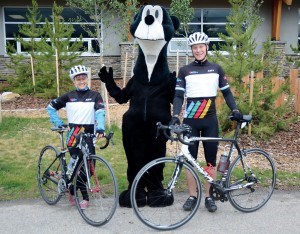 As with all sports, cycling has it’s own language. Don’t be left out of the conversation when the Tour of Alberta rolls through Jasper National Park Sept. 4-5, check out this handy guide to cycling lingo and practice up so you can impress your friends.
As with all sports, cycling has it’s own language. Don’t be left out of the conversation when the Tour of Alberta rolls through Jasper National Park Sept. 4-5, check out this handy guide to cycling lingo and practice up so you can impress your friends.
Attack – Breaking away from the pack with the intention of placing at the finish line. It’s also called a break or breakaway.
Blocking – When one rider, or a group of riders, disrupts a chase by slowing down a paceline.
Bridge or bridge a gap – To catch a rider or group that has opened a lead.
Bunch sprint – When a group of riders approach the finish line together and all speed to the finish line.
Chasers – Riders who are trying to catch a breakaway group.
DNF – Did Not Finish.
DNS – Did Not Start.
Domestique – Translated from French, domestique means servant. The term is for a rider who sacrifices his performance to help a designated teammate. He can do that by giving up his bike, resupplying his teammate with refreshments and food or by catching breakaway riders.
Drafting – Riding closely behind another rider or vehicle to take advantage of the windbreak (slipstream). This is done to conserve energy. Drafting can use about 20 per cent less energy.
Feed zone – A designated area where riders can grab bags filled with food and drinks as they ride by.
Field sprint – A mass sprint to the finish line by the main group of riders.
Gap – The distance (usually measured in time) between individuals or groups.
General Classification (G.C.) – The overall leader board in the race, representing each rider’s total cumulative time. The rider with the lowest time is number one on the G.C. And at the end of the race, the winner.
KOM – King of the Mountain. Awarded to the best climber.
Mountain climb classification – Large mountain climbs are classified based on their level of difficulty. Category 4 is the easiest, followed by Categories 3, 2, 1, and the Hors-Categorie (French for above classification), which is the most difficult. Mountain climbs are classified according to their length and the average gradient of the road’s incline.
Paceline – A group formation where each rider takes a turn setting the pace at the front before pulling off, dropping to the rear position, and riding the others’ draft until at the front once again.
Peloton – The main field, or pack of riders in the race. Peloton is French for a group moving forward. When the group is strung out, long and thin, the peloton is traveling at a fairly high speed.
Prologue – Short individual time trial to begin a stage race.
Slipstream – The area of least wind resistance behind a rider.
Stage race – A bike race held over successive days, with a different course each day. Stage races last anywhere from three days to three weeks. The rider with the lowest total time (or accumulated points) after completion of all the stages wins the overall race.
Train – A fast moving paceline of riders.
For more jargon, check out the Tour of Alberta’s website for a full list of cycling terms.
The Tour of Alberta is a professional bike race that attracts the same cyclists that compete in the Tour de France. The third annual event will be in Jasper Sept. 4 and 5, with two mountaintop finishes, one at Miette Hot Springs and another at Marmot Basin.
During the race, there will be festivals taking place at the finish lines, as well as on the information centre lawn. To learn more about the tour and what Jasper’s doing while it’s here, visit www.jasper.travel/tourofalberta. To volunteer for the event, fill out the application form at www.tourofalberta.com.
